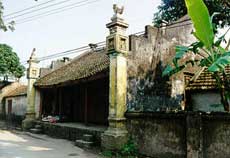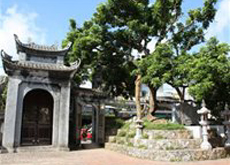Hung Yen, a northern province endowed with many ancient historical and cultural relics, some of them recognized as national sites are fascinating lots of visitors.
 The charming beauty of the Hung Yen terrain extends all the way to the streets of the city where lotus ponds flourish and the canals wind sinuous paths to ever-green rice fields. Villages in Hung Yen are located at river basins or scattered around the rice fields which are surrounded by green bamboo clumps.
The charming beauty of the Hung Yen terrain extends all the way to the streets of the city where lotus ponds flourish and the canals wind sinuous paths to ever-green rice fields. Villages in Hung Yen are located at river basins or scattered around the rice fields which are surrounded by green bamboo clumps.
Traditionally, each village has a communal house next to a century-old banyan tree and a big water well which is stamped deeply onto the minds of the locals from childhood and leaves a permanent stamp on the minds of expatriates as well.
Looming behind the green bamboo clumps are the communal houses, pagodas, temples and shrines. Even from a distance, the roof of the communal house can be seen among luxuriant green tree canopies. Huge ancient trees surround the house and their green leaves embellish the roofs, making the scenery more vivid. Most pagodas and temples are surrounded by banyans, fig trees and longan trees which all stay green year round.
One of stunning places in Hung Yen Province is Pho Hien (Hien Street) which is located in Hung Yen City, about 60km from Hanoi.
During the 17th and 18th centuries, Pho Hien was once a frontal port of Thang Long Citadel that opened to the sea, ranking second in importance to Thang Long (Hanoi today), as goes an old Vietnamese saying "One should first visit Thang Long and then Pho Hien".
Nowadays, Pho Hien gave up its position as a commercial port to Haiphong, and kept only its ancient cultural significance. In Pho Hien, there is still a whole architectural complex of 60 historical vestiges, 100 engraved stelae, and many temples and pagodas.
The Pho Hien relic complex, of which Mau Temple is a highlight, is an attraction and a mystery. Once stepping into the temple, travelers will be amazed by the huge seven-hundred-year-old tree which makes a domed gate for the temple. Different from other temples in the country that honor powerful Vietnamese women or Goddesses, Mau Temple is dedicated to worshipping Yang Guifei (Duong Quy Phi in Vietnamese), a beauty lady in Tang Dynasty, who was one of the Four Beauties of ancient China. Legend has it that those who touch the palanquin, which is used in the lady procession, will have good health and good luck. Half–moon shaped lake in front of the temple is also a nice place waiting for travelers’ footprints.
Another attraction tourists should not miss is the huge longan tree, called Nhan To, in front of Hien Pagoda. Believed to be 300 years old, the tree is a sacred place for locals as they believe the tree brings prosperity to the land. The caged longan (the name comes from the technique of covering the longans with cages to protect them from the birds) is a specialty of Pho Hien that is famous throughout the country. The caged longan has a thick pulp and a thin peel and is very sweet. The caged longans of Hien Street used to be offered to kings.
 Another relic of the Pho Hien relic complex worth visiting is Thien Hau Temple. This temple is dedicated to worshipping Lam Tuc Mac, a nautical goddess of China. The temple attracts pilgrims for annual festivals on the 23rd day of the third lunar month and the 9th day of the ninth lunar month.
Another relic of the Pho Hien relic complex worth visiting is Thien Hau Temple. This temple is dedicated to worshipping Lam Tuc Mac, a nautical goddess of China. The temple attracts pilgrims for annual festivals on the 23rd day of the third lunar month and the 9th day of the ninth lunar month.
Dong Do Quang Hoi Temple was a former meeting place for traders, mainly from China, and worships three gods who are honored in a festival at the temple on the tenth day of the tenth lunar month. This temple in Chinese architecture is historical records of commerce between Vietnam and China.
Chuong (Bell) Pagoda is endowed with poetic scenery and boasts a stone bridge spanning a lotus pond and 18 statues of Arhats. Hung Yen Literature Temple holds a collection of ancient steles.
Other relics of Pho Hien having Vietnamese architecture are decorated with the colors of folk belief and religion, and some are evaluated highly in artistic value. Along with their architectural features, these relics have preserved utensils for religious offerings, palanquins, hammocks, horizontal lacquered boards and many pairs of wood panels with skillfully inscribed parallel sentences.
More importantly, the relics of Pho Hien preserve their native ancient beauties. With the wet rice civilization and culture, visitors can catch the colors of bronze, stone, wood, tile and soil on each roof, door and path, which create a sense of immortality of each relic.
People who live in Pho Hien area are embracing the ambition to revive the glorious past and trying to keep and protect the valued remains.
Hung Yen is waiting for all visitors who desire to back to touch ancient values.
More information
From Hanoi to Hung Yen, visitors can catch bus No. 205 from the Luong Yen Bus Station to Hung Yen Bus Station or bus No. 209 from the Giap Bat Bus Station to Hung Yen Bus Station.
Time:Everday from 5am to 8pm, there is a bus every 15 or 20 minute.
Price: VND 18,000.
Phuong Anh (Edited)